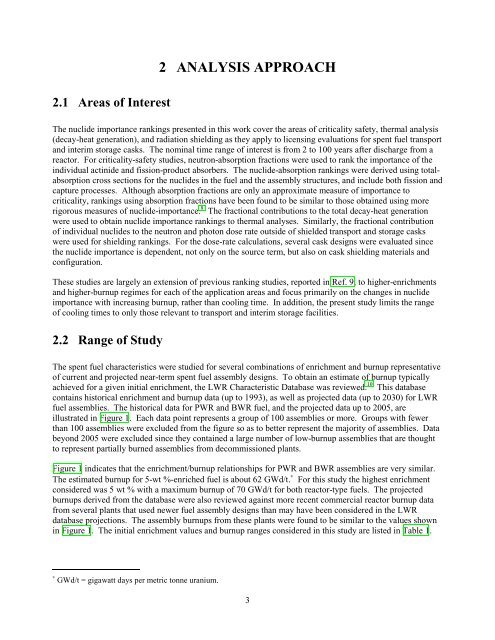nureg/cr-6700 - Oak Ridge National Laboratory
nureg/cr-6700 - Oak Ridge National Laboratory
nureg/cr-6700 - Oak Ridge National Laboratory
You also want an ePaper? Increase the reach of your titles
YUMPU automatically turns print PDFs into web optimized ePapers that Google loves.
Section 1 Analysis Approach<br />
2.1 Areas of Interest<br />
2 ANALYSIS APPROACH<br />
The nuclide importance rankings presented in this work cover the areas of <strong>cr</strong>iticality safety, thermal analysis<br />
(decay-heat generation), and radiation shielding as they apply to licensing evaluations for spent fuel transport<br />
and interim storage casks. The nominal time range of interest is from 2 to 100 years after discharge from a<br />
reactor. For <strong>cr</strong>iticality-safety studies, neutron-absorption fractions were used to rank the importance of the<br />
individual actinide and fission-product absorbers. The nuclide-absorption rankings were derived using totalabsorption<br />
<strong>cr</strong>oss sections for the nuclides in the fuel and the assembly structures, and include both fission and<br />
capture processes. Although absorption fractions are only an approximate measure of importance to<br />
<strong>cr</strong>iticality, rankings using absorption fractions have been found to be similar to those obtained using more<br />
rigorous measures of nuclide-importance. 8 The fractional contributions to the total decay-heat generation<br />
were used to obtain nuclide importance rankings to thermal analyses. Similarly, the fractional contribution<br />
of individual nuclides to the neutron and photon dose rate outside of shielded transport and storage casks<br />
were used for shielding rankings. For the dose-rate calculations, several cask designs were evaluated since<br />
the nuclide importance is dependent, not only on the source term, but also on cask shielding materials and<br />
configuration.<br />
These studies are largely an extension of previous ranking studies, reported in Ref. 9, to higher-enrichments<br />
and higher-burnup regimes for each of the application areas and focus primarily on the changes in nuclide<br />
importance with in<strong>cr</strong>easing burnup, rather than cooling time. In addition, the present study limits the range<br />
of cooling times to only those relevant to transport and interim storage facilities.<br />
2.2 Range of Study<br />
The spent fuel characteristics were studied for several combinations of enrichment and burnup representative<br />
of current and projected near-term spent fuel assembly designs. To obtain an estimate of burnup typically<br />
achieved for a given initial enrichment, the LWR Characteristic Database was reviewed. 10 This database<br />
contains historical enrichment and burnup data (up to 1993), as well as projected data (up to 2030) for LWR<br />
fuel assemblies. The historical data for PWR and BWR fuel, and the projected data up to 2005, are<br />
illustrated in Figure 1. Each data point represents a group of 100 assemblies or more. Groups with fewer<br />
than 100 assemblies were excluded from the figure so as to better represent the majority of assemblies. Data<br />
beyond 2005 were excluded since they contained a large number of low-burnup assemblies that are thought<br />
to represent partially burned assemblies from decommissioned plants.<br />
Figure 1 indicates that the enrichment/burnup relationships for PWR and BWR assemblies are very similar.<br />
The estimated burnup for 5-wt %-enriched fuel is about 62 GWd/t. ∗ For this study the highest enrichment<br />
considered was 5 wt % with a maximum burnup of 70 GWd/t for both reactor-type fuels. The projected<br />
burnups derived from the database were also reviewed against more recent commercial reactor burnup data<br />
from several plants that used newer fuel assembly designs than may have been considered in the LWR<br />
database projections. The assembly burnups from these plants were found to be similar to the values shown<br />
in Figure 1. The initial enrichment values and burnup ranges considered in this study are listed in Table 1.<br />
∗ GWd/t = gigawatt days per metric tonne uranium.<br />
3

















